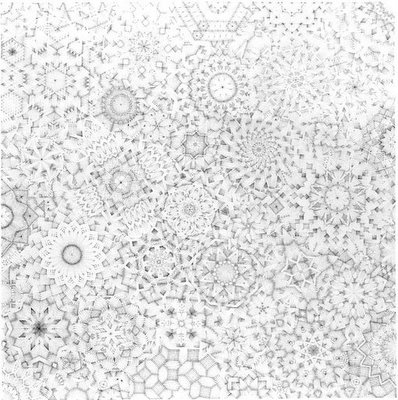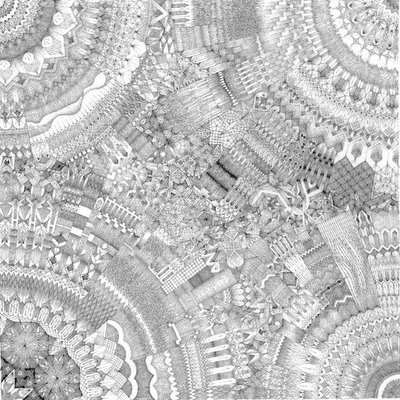
Evolution-Completion Idea
by Donald Burgy
December 1973
[a Ghost Town Orange reproduction of a work found in "Donald Burgy: Participating in the Universe,"
by Robert Joseph Horvitz in Artforum September 1974]
Click image for a larger view for readability; the swirly, crinkly background texture is my 'artsy' addition and not part of the original work, which was deliberately left unornamented so the viewer would not be distracted by the 'artifact' itself.
Here is Robert Horwitz's perception of Evolution-Completion Idea:
Many of Burgy's works are meant to be completed by the viewer in a more literal sense. Evolution-Completion Idea (December, 1973), for instance, is a quiz-like series of historical progressions whose next stages are left blank for each viewer to complete. As the last terms given are those of the present, one must extrapolate stages that have not yet occureed. By dividing the progressions into intervals of seemingly equal magnitude, Burgy makes the unnamed future seem only a step away, even though tremendous breakthroughs and centuries of "real time" may be required in taking that step; peculiarly enough, one almost feels that in formulating responses to this questionnaire one has added to the teleological pressure that will eventually create these epochal transformations.Dear reader, spend some time thinking about how you would fill in the blanks.
The author of the article, Robert Horvitz, is also an artist. I am sure I have seen some of his art in the past because my ballpoint pen doodlings share some of the same fascinations with pattern and symmetry. According to a five-minute long interview available at Radio Prague [about this exhibit], he has been using the same drawing technique for over 30 years, using one type of pen stroke for all his work. He describes the motion as a 'flick' of the pen which leaves a comet-like mark on the paper. He repeats the same mark 1000s of times to produce his drawings, most of which take 3 to 5 days to complete.
At another website, you can find excerpts from the catalog for the exhibit 'Revelations': Drawings by Robert Horvitz, 1970-1999. I am intrigued by the vocabulary Mr. Horvitz has developed to describe the forms he draws:
I had also begun making drawings based on grids drawn in pencil. (Grids have more ambiguous time-orders than spirals.)... Very quickly I saw that grids could be replaced by more general structures - arrays of cells, polygon tilings and froths...Geometry not only could be but, according to modern science, MUST be elastic, topological, based on similarities rather than equalities. This opened my mind to more dynamic forms: flows, decays, rips, shards, close-packings, eruptions, etc. These were more richly allegorical than the Euclidean motifs I had been using...Arrays and tilings were terms I have used when thinking about my doodles, but froths, flows, decays, rips, shards, packings, eruptions...! My doodling will be even more inventive with this new vocabulary to work with. Here are a couple of my favorites, although this is not a representative sampling of Mr. Horvitz's work. I wish I had higher resolution images of these to look at!

Personal Domain of Freedom and Ecstasy 6
by Robert Horwitz
1975

Personal Domain of Freedom and Ecstasy 2
by Robert Horwitz
1973
Docetism is the ancient heresy that Christ did not in fact have a real body at all but only seemed to have one. This thinking remains alive and well today in the hearts and minds of many who say he was human as well as divine but in fact do not believe and cannot even imagine that he had a full-fledged human body. They cannot do so because we tend to think of the body and its functions as only a hindrance to our spiritual calling, with no positive role in our redemption or in our participation in the government of God.
--Dallas Willard, The Spirit of the Disciplines: Understanding How God Changes Lives, 1988
--Dallas Willard, The Spirit of the Disciplines: Understanding How God Changes Lives, 1988
